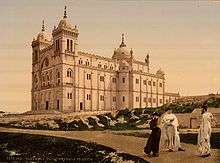Acropolium of Carthage
The Acropolium, also known as Saint Louis Cathedral (French: Cathédrale Saint-Louis de Carthage), is a Roman Catholic church located in Carthage, Tunisia.
| Acropolium of Carthage Cathédrale Saint-Louis de Carthage | |
|---|---|
 Acropolium of Carthage | |
| Religion | |
| Affiliation | Roman Catholic Church |
| Province | Roman Catholic Archdiocese of Tunis |
| Ecclesiastical or organizational status | Cathedral |
| Status | Inactive |
| Location | |
| Location | Carthage, Tunisia |
| Geographic coordinates | 36.853784°N 10.323356°E |
| Architecture | |
| Type | church |
| Groundbreaking | 1884 |
| Completed | 1890 |
The cathedral sits on the peak of Byrsa Hill, near the ruins of the ancient Punic and then Roman city. It was built atop the ruins of an old temple dedicated to Eshmun, the Punic god of healing. The edifice can still be accessed from the basement.
Since 1993, the cathedral has been known as the "Acropolium". It is no longer used for worship, but instead hosts public events or concerts of Tunisian music and classical music. Currently, the only Roman Catholic cathedral operating in Tunisia is the Cathedral of St. Vincent de Paul in Tunis.
History
Hussein II Bey authorised the French consul-general to build a cathedral on the site of ancient Carthage, to determine where it would be situated and to take all the land necessary for the project. His words were:
Praise to the one God, to whom all things return!
We cede in perpetuity to His Majesty the King of France a location in the Malka, sufficient to raise a religious monument in honour of King Louis IX at the place where this prince died.[1] We commit ourselves to respect and to make respected this monument consecrated by the King of France to the memory of one of his most illustrious ancestors. Greetings from the servant of God, Hussein Pasha Bey. May the Most High be propitious! Amen.
The 17th of Safar of the year 1246. Done at Bardo the 8th of August 1830. For the consul-general Mathieu de Lesseps.
The consul charged his son Jules with this duty. The latter, having closely examined possible sites, concluded that the chapel ought to be built on Byrsa Hill, in the centre of the Punic acropolis, where the temple of Aesculapius was once located. King Louis-Philippe approved the project. The architect chosen conceived a building of modest proportions that contained a mix of Gothic and Byzantine architectural styles. In any case, he succeeded in giving it the look of a rich marabout while recalling the royal chapel at Dreux. A cross, the only one standing at that time in Tunisia, topped the building.[2] Descendants of crusaders' families, companions of the sovereign, helped finance the construction.

Built between 1884 and 1890, under the French protectorate, the cathedral acquired primacy for all of Africa when the title of primate of Africa was restored for the benefit of Cardinal Lavigerie, titular of the Archdioceses of Algiers and of Carthage, united in his person. The building was consecrated with great pomp in the presence of numerous ecclesiastical dignitaries.[3]
After his death, Cardinal Lavigerie was buried there and a funerary monument was erected in his memory. However, his body now lies in the General Curia of the White Fathers, in Rome.
Architecture
Late 19th century French architecture tended to feature composite styles (as in the case of the Basilica of the Sacré Cœur in Paris, built in the Romanesque-Byzantine architectural tradition in the same era). The building, constructed according to the plans of the abbot Pougnet, has a Byzantine-Moorish style, and is in the shape of a Latin cross of 65 meters by 30. The façade is framed by two square towers, the crossing lies beneath a large cupola surrounded by eight little steeples, and there is a smaller cupola above the apse. The church contains a nave and two aisles separated by arches passing above. Its ceiling is adorned with beams that have sculpted, painted and gilt arabesques on them. The stained glass also features arabesques. The great bell weighs six tons and there is a four-bell carillon as well.
_-_Fondo_Mar%C3%ADn-Kutxa_Fototeka.jpg) Cathedral during the XXX Eucharistic Congress (1930)
Cathedral during the XXX Eucharistic Congress (1930) Side view
Side view Nave
Nave
References
| Wikimedia Commons has media related to Saint Louis Cathedral, Carthage. |
- In 1270, the Eighth Crusade arrived before Tunis. Hoping to convert the Sultan of Tunis to Christianity and use him to fight against the Sultan of Egypt, the crusaders easily took Carthage but the army was struck by an epidemic of dysentery. Louis IX (Saint Louis) died on 25 August. Part of his remains were buried in Tunisia; the tomb containing them can be visited today.
- Mgr Alexandre Pons, La nouvelle Église d'Afrique ou le catholicisme en Algérie, en Tunisie et au Maroc depuis 1830. ed. Librairie Louis Namura, Tunis, 1930
- For this occasion, some relics of Saint Louis kept in Sicily were brought by the Archbishop of Palermo for, before Saint Louis' body could be brought back to France, problems conserving it made it necessary for his innards to be left in Sicily. When Tunisia became independent, these relics were taken to France and deposited in Sainte-Chapelle.